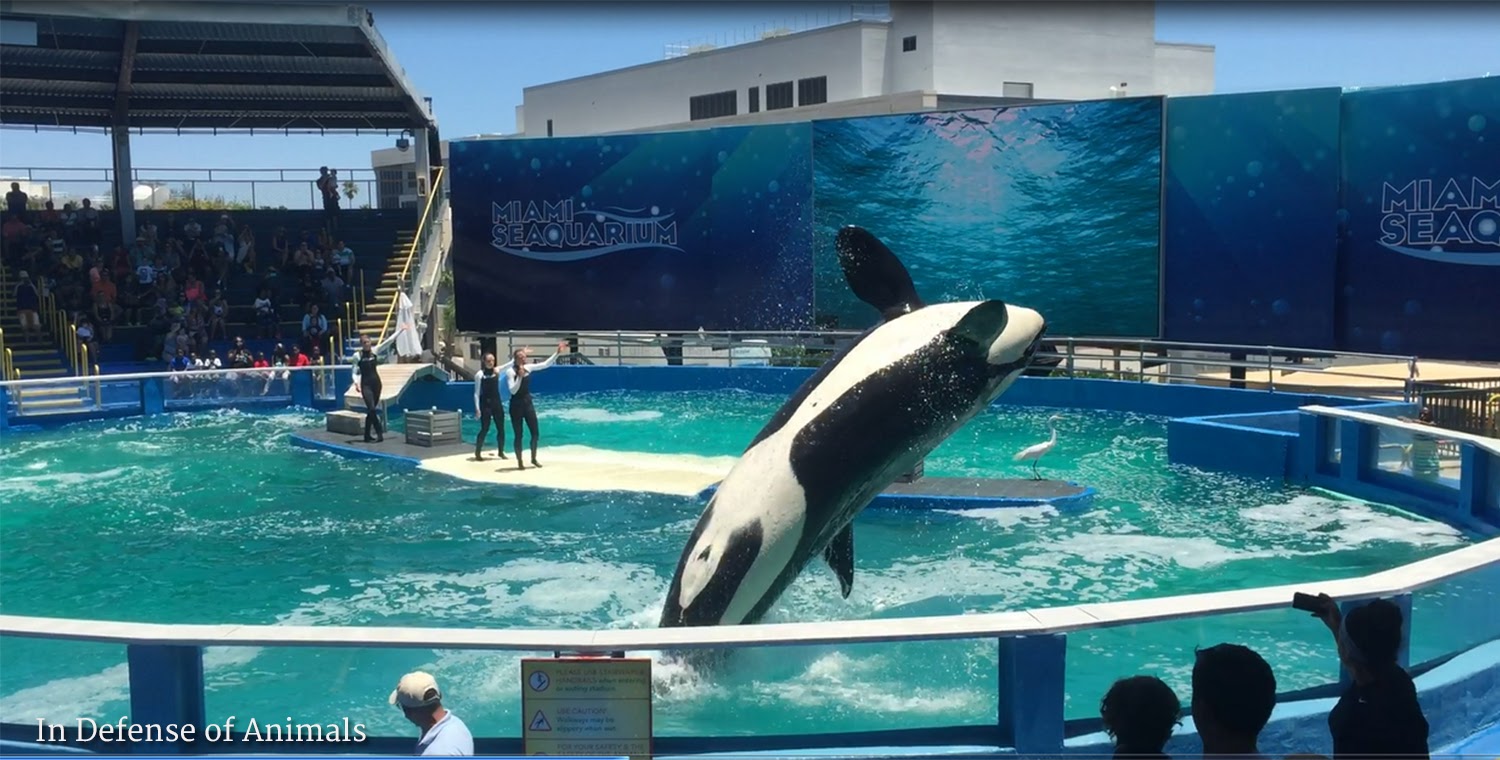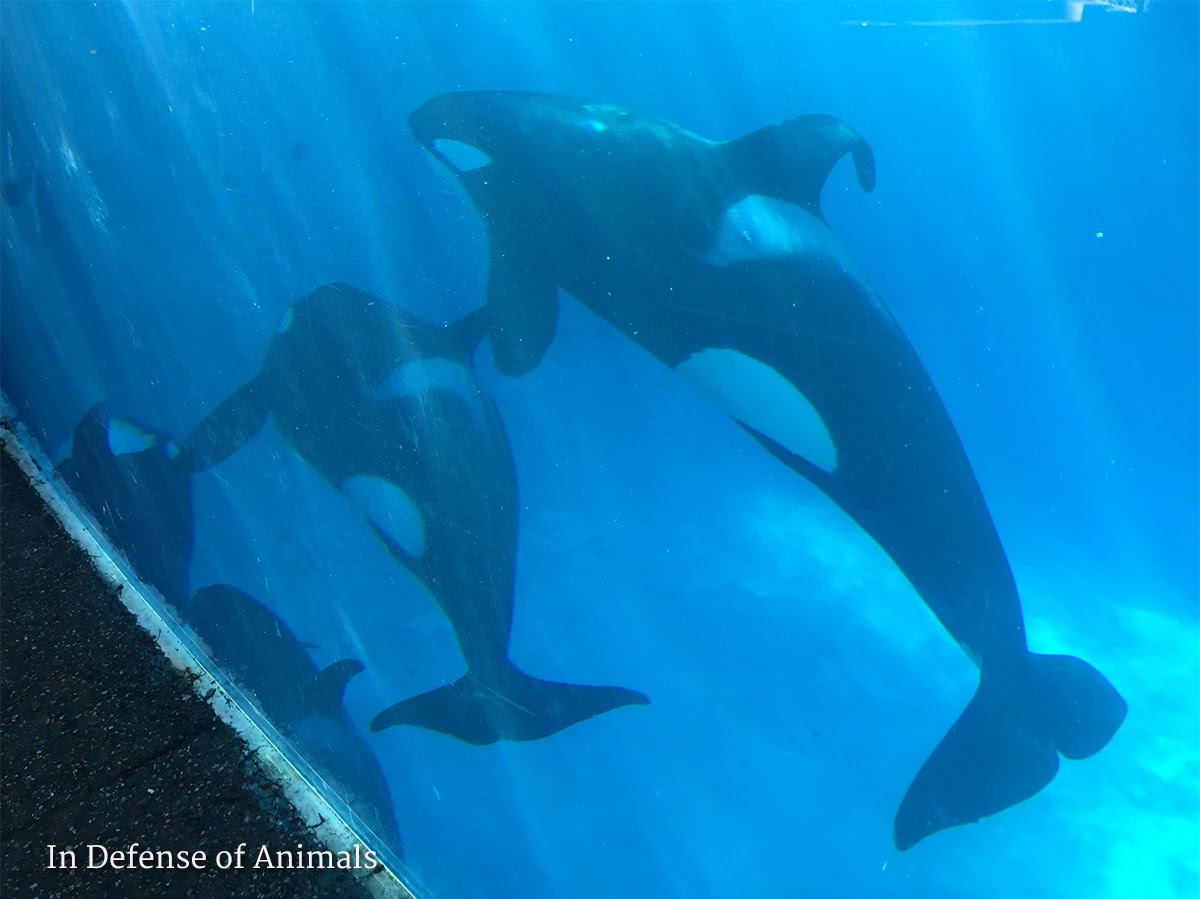Around the world, dolphins and whales in captivity are a popular form of entertainment. Collectively known as cetaceans, these animals can be forced to perform tricks in circus-like environments, including in dolphinariums or aquariums. Globally, dolphins and whales in captivity form a multi-billion dollar industry.
But the dark side of this industry is kept well-hidden. The unfortunate reality is that dolphins and whales in captivity suffer greatly behind the glitz and glamor of these businesses.
Below are five facts about the conditions cetaceans endure within captive environments. For a more in-depth look at specific facilities, and other issues affecting wild cetaceans, check out our Cetacean Project page.

1. Types of dolphins kept in captivity
Bottlenose dolphins are the most common species of cetacean used in the dolphin and whale captivity industry. The next most popular species are orca whales, also known as killer whales. The name is a bit of a misnomer, however, since orcas are actually a species of dolphin, not a species of whale.
Whales are also kept in captivity, such as the pure-white beluga whales. However, larger species of whales, such as humpbacks and right whales, are too large for any captive display facility to handle.
2. Number of Dolphins Held Dolphins in Captivity
Since captivity businesses aren’t always required to report births and deaths, it is difficult to quantify exactly how many dolphins and whales are held captivity. One analysis in 2015 pegged the number at close to 3,000 individuals being held in tanks around the world, with the United States accounting for over 500 individuals.
3. Lifespan of Dolphins and Whales in Captivity
There isn’t a broad consensus on how long dolphins live in the wild versus captivity. One study pegged dolphin life expectancy in captivity at around 30 years of age, while another produced the figure of around 12 years. Yet dolphins have been known to live well into their 60s.
Even if the median life expectancy for dolphins in captivity is similar to those in the wild, this isn’t saying much to benefit the captivity industry. Captivity facilities often tout their medical care, the fact that dolphins are shielded from predators, and that they do not have to forage for food as being some of the benefits of a life in captivity, making dolphin's lives “easy.” However, if these factors were actually contributing to a dolphins’ wellbeing, captives should be far outliving wild dolphins. This is absolutely not the case - and thus forms more evidence for how dolphins suffer impoverished lives in captivity.
4. Dolphin Depression Syndrome
There is plenty of evidence suggesting that dolphins show symptoms of being depressed in captivity. Dolphins can engage in stereotypic behaviors, ranging from repetitive motions or unnatural behaviors that are only seen in captive individuals.
It is believed that stereotypic behaviors are a direct effect of captivity on dolphins. They arise due to chronic impairment of mental and emotional welfare and can result from boredom, lack of stimulation, stress, depression, or any number of other psychological states.
When you know what to look for regarding stereotypic behaviors, you will begin seeing them pretty much anywhere dolphins and whales are held captive.
In the wild, cetaceans travel many miles each day and are not often found drifting lethargically at the surface of the water. Yet this behavior, known as logging, is considered stereotypic in captivity given the unusually prolonged periods cetaceans have been observed engaging in this behavior. Other stereotypies include chewing endlessly on bars or grates; swimming in the same pattern around the tank for hours; bobbing their heads or popping their jaws repetitively; and the list goes on.
Captivity businesses are known to give cetaceans drugs that treat depression in humans. A bombshell discovery uncovered by Buzzfeed in 2014 revealed that SeaWorld, the global industry leader in the captivity industry, administers benzodiazepine to killer whales.
Benzodiazepine is a psychoactive drug included in common human medications such as Xanax and Valium.
Documents show that SeaWorld uses benzodiazepine to prevent aggressive behaviors in killer whales. However, experts believe this aggression is the result of chronic stress rather than the sort that can be attributed to this species’ natural tendencies.

5. Captivity Deforms Dolphins’ Bodies
There are many ways that the bodies of dolphins and whales in captivity become deformed due to captivity.
Orcas can suffer from dorsal fin collapse, where their iconic tall fin - which can reach heights of six feet in the wild - flops over into a hump. It is believed that the constant movement of water due to wild orcas' movement and traveling is what helps keep these fins upright in the wild. The stagnant lifestyle in captivity cannot provide the necessary hydrodynamic resistance needed.
In aquariums where dolphins are forced to perform circus-style shows, trainers and performers often stand on the backs and even the faces of dolphins, using their bodies as surfboards to entertain crowds. These shows are performed so often that dolphins begin to develop open sores on their bodies, for example on the tips of their rostrums, or their “beaks.”
As the skin of dolphins is extremely sensitive, these wounds likely cause dolphins constant pain.
Stereotypic behaviors can cause severe damage to the bodies of dolphins and whales.
Dolphins and orcas sometimes chew the grates to their tanks so frequently that they break down their teeth. This requires veterinarians to drill and flush their damaged jaws to prevent infection.
6. Dolphins and Whales Are Trained through Food Deprivation
If you’ve ever watched a dolphin show, you will notice that after many tricks the dolphins will swim over to the trainers, who will toss them fish or treats.
What you are witnessing is essentially the bribing of dolphins in order to force them to perform as desired. Though some venues like to say that they showcase “natural behaviors” of cetaceans during these shows, the truth is that dolphins wouldn’t repeat these same tricks over and over, day in and day out, in the wild.
There is nothing natural about a dolphin or whale performance.
Furthermore, in many cases, food is actively withheld from cetaceans throughout the day. Leaving cetaceans on the verge of extreme hunger compels them into obedience all the more effectively. So, it is highly likely that dolphins and whales in captivity not only endure the poor conditions of barren tanks, but they are also chronically hungry.
7. They Remember Their Way Home After Being Freed
Dolphins and whales are frequently captured from the wild in order to restock tanks around the world. Yet the captivity industry regularly claims that returning them to the sea is impossible.
The story of two dolphins captured and held illegally in South Korea illustrates an important example of how releasing cetaceans from captivity can, in fact, be successful. After four long years in captivity, bottlenose dolphins Sampal and Chunsam were placed in a temporary sea pen to recalibrate them to life in the ocean. Ahead of their release date, Sampal discovered a hole in the netting and escaped.
Only five days later, she was seen back with her family from which she’d been taken all those years ago. Chunsam was released shortly thereafter and was soon seen swimming with individuals of his old pod as well.
Not only did these dolphins adjust back to life in the wild, but after four years, they knew exactly where to go to find their families and friends. This is no coincidence.
It has been proven that dolphins have sophisticated cognitive and emotional abilities, and as this case suggests, long memories as well. This also means that dolphins and whales captured from the wild who remain in tanks to this day are likely haunted with memories of the life and families they’ve lost.
8. Captivity Teaches Domination Rather Than Respect
There’s no conclusive evidence that viewing dolphins and whales in captivity promotes attitude change or spurs an interest in conservation within visitors.
Zoos and aquariums alike tend to promote their facilities to children, who are impressionable and still learning about the world. These companies overtly encourage children to develop emotional bonds with animals who are in permanent confinement.
The resulting education conflates love with domination, and pushes the notion that it is morally acceptable for wild animals to be utterly dominated by humans. Additionally, it sends the clear, yet misguided and unproven messages that animals do not notice their poor living conditions or that they appreciate the “care” they receive at these facilities.
Ultimately, the captivity industry normalizes animals in cages, enabling these businesses to continue to profit at animals’ expense.
How Can We Help Dolphins In Captivity?
Dolphins and whales suffer greatly in captivity, regardless of the size of the tanks. Chronic stress, physical injuries, and food deprivation paint an image of the kind of lives these animals are forced to endure, all for the sake of human entertainment and profit.
There are many things you can do to help dolphins and whales in captivity. Here are a few suggestions
- Do not patronize places that keep cetaceans captive, whether it be for shows, educational displays, or swim-with-dolphin programs. Reducing the financial demand for these places is critical in stopping the industry from continuing to exploit cetaceans.
- Educate yourself on the issues, then spread the word to your family and friends. Hold community screenings of documentaries and host discussions afterward to help spread the world. For example, Blackfish, available on Netflix, takes a deep dive into the orcas at SeaWorld.
- Visit our cetacean Take Action page regularly to call and email captivity business owners, or state or federal representatives, on a number of issues, including getting important legislation passed to help cetaceans.

